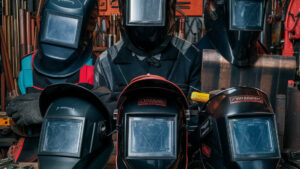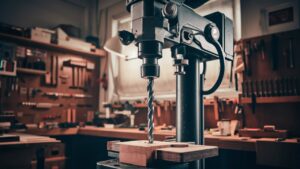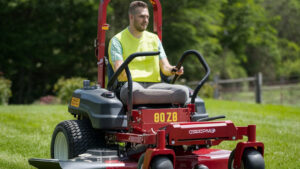Yes, you need a special welder for aluminum. Standard welding equipment often doesn’t work well with this lightweight metal.
Recommended Best Welder for Aluminum 2025
| Recommendation | Product |
| Best Overall | LOTOS MIG225SP MIG Welder |
| Popular Choice | TOOLIOM 200A MIG Welder 5 in 1 |
| Best Value | ARCCAPTAIN 6-in-1 Aluminum MIG Welder |
| Best Budget | YESWELDER 135Amp MIG Welder |
| Another Excellent Pick | RUBIK Aluminum 250Amp MIG Welder |
Welding aluminum requires specific techniques and equipment due to its unique properties. Unlike steel, aluminum is more prone to warping and requires precise heat control. The right welder will typically use either TIG (Tungsten Inert Gas) or MIG (Metal Inert Gas) welding methods.
Choosing the correct filler material is also crucial for a strong bond. Aluminum’s high thermal conductivity means it dissipates heat quickly, making proper settings essential. Understanding these factors can significantly improve your welding results. Whether you are a hobbyist or a professional, investing in the right tools will ensure successful aluminum welding projects.
The Challenge Of Welding Aluminum
Welding aluminum presents unique challenges. Its properties differ greatly from steel. Understanding these differences is essential for effective welding.
Unique Properties Of Aluminum
Aluminum has several unique characteristics that impact welding:
- Lightweight: Aluminum is much lighter than steel.
- High Thermal Conductivity: It heats up quickly, affecting weld quality.
- Oxide Layer: A tough oxide forms on the surface, complicating the weld.
- Low Melting Point: It melts faster, which can lead to warping.
Common Issues In Aluminum Welding
Welding aluminum can lead to various problems:
| Issue | Description |
|---|---|
| Porosity | Gas pockets form in the weld, weakening it. |
| Cracking | Rapid cooling can cause cracks in the weld. |
| Inadequate Penetration | Weld does not penetrate the base metal properly. |
| Distortion | Heat causes the aluminum to warp or bend. |
Proper techniques and equipment can minimize these issues. Choose the right welder for aluminum projects. Always prepare surfaces well before welding.

Types Of Welders Suitable For Aluminum
Choosing the right welder for aluminum is crucial. Different welders offer unique advantages. Each type suits specific tasks and skills. Here’s a look at the most suitable options.
Tig Welders For Precision
TIG welding is ideal for precision work. This method provides high-quality welds. It uses a non-consumable tungsten electrode. Here are its main benefits:
- Control: Offers excellent control over the weld pool.
- Clean Welds: Produces clean, aesthetically pleasing welds.
- Thin Materials: Works well with thin aluminum sheets.
Considerations:
- Skill Level: Requires more skill and practice.
- Speed: Slower than other welding methods.
Mig Welders For Versatility
MIG welding is versatile and user-friendly. It uses a continuous wire feed. This method is great for various aluminum thicknesses. Key features include:
| Feature | Advantage |
|---|---|
| Speed: | Faster than TIG welding. |
| Ease of Use: | Good for beginners and experts. |
| Portability: | Easy to set up and move. |
Considerations:
- Weld Quality: May not match TIG for precision.
- Cleaning: Requires clean surfaces for best results.
Alternatives: Stick Welding Aluminum
Stick welding is another option for aluminum. It uses an electrode coated with flux. This method is less common but has advantages:
- Cost: Generally cheaper to set up.
- Portability: Good for outdoor work.
- Versatility: Can weld various metals.
Considerations:
- Weld Quality: May not be as clean as MIG or TIG.
- Skill Level: Requires more practice for good results.
Choosing The Right Welder For Your Project
Choosing the right welder for aluminum projects is crucial. Different types of welders work better for specific tasks. Understanding your project’s needs helps you make the best choice.
Assessing Thickness Of Aluminum
The thickness of aluminum affects the type of welder needed. Thicker materials require more power. Here’s a simple guide:
| Aluminum Thickness | Recommended Welder Type |
|---|---|
| Less than 1/8 inch | MIG Welder |
| 1/8 inch to 1/4 inch | TIG Welder |
| Over 1/4 inch | Stick Welder |
This table helps you choose the right welder based on thickness. Always check the specifications of your aluminum sheets.
Project Scale And Welder Power
The scale of your project determines the power needed. Small projects can use less powerful welders. Larger projects need more robust machines.
- For small tasks:
- MIG or TIG welders are ideal.
- Easy to handle and transport.
- For large tasks:
- Stick welders or industrial MIGs work best.
- More power for thicker materials.
Consider the power output of your welder. Check the amperage rating. Ensure it matches your project needs.
Preparation Tips For Welding Aluminum
Welding aluminum requires careful preparation. Proper steps ensure strong and clean welds. Follow these tips to enhance your welding experience.
Cleaning Aluminum Before Welding
Cleaning aluminum is crucial for a successful weld. Any dirt, oil, or oxidation can weaken the joint. Here are steps to clean aluminum:
- Use a Degreaser: Apply a degreaser to remove oil.
- Scrub with a Wire Brush: This helps remove oxidation.
- Rinse with Water: Wash off any cleaning agents.
- Dry Thoroughly: Ensure the surface is completely dry.
For best results, clean right before welding. Contamination can occur quickly. Use a clean cloth to wipe the area again.
Proper Aluminum Storage
Storing aluminum correctly is vital. Proper storage prevents contamination and damage. Follow these guidelines:
| Storage Method | Description |
|---|---|
| Indoor Storage | Store in a dry, clean area. |
| Protective Covers | Use covers to shield from dust. |
| Avoid Ground Contact | Keep aluminum off the ground. |
Proper storage extends the life of aluminum. It reduces the risk of damage. Always inspect aluminum before use.
Techniques For Successful Aluminum Welding
Welding aluminum requires specific techniques for the best results. Mastering these methods ensures strong, clean welds. Let’s explore key techniques for effective aluminum welding.
Mastering Heat Control
Heat control is vital in aluminum welding. Too much heat can warp the metal. Too little heat leads to weak joints.
- Use a consistent welding speed.
- Choose the right amperage for your welder.
- Keep the torch at a steady angle.
Monitor the temperature of the aluminum. A thermometer can help. This ensures optimal heat levels throughout the process.
Avoiding Contamination
Contamination can ruin weld quality. Clean surfaces before starting. Dirt, oil, and oxidation can cause issues.
- Use a wire brush or grinder.
- Apply a solvent to remove oil.
- Weld in a clean environment.
Keep filler rods clean. Store them in a dry place. This prevents moisture buildup.
Essential Tools And Accessories
Welding aluminum requires specific tools and accessories. The right equipment ensures a strong and clean weld. Below are essential items every aluminum welder should have.
Using The Right Electrode
Choosing the correct electrode is crucial for aluminum welding. Here are some common types:
| Electrode Type | Description |
|---|---|
| ER4047 | Ideal for welding aluminum alloys with a good flow. |
| ER5356 | Best for high-strength applications and marine environments. |
| ER4045 | Offers excellent corrosion resistance and good strength. |
Always match the electrode to the aluminum type. Using the wrong one can lead to weak joints.
Importance Of A Welding Helmet
A welding helmet protects your eyes and face from harmful sparks. It also shields against bright light and UV rays. Choose a helmet with these features:
- Auto-Darkening Lens: Adjusts to light changes.
- Comfortable Fit: Ensures long working hours without discomfort.
- Good Visibility: Clear view of the welding area.
Wearing a helmet is not optional. It is a must for safety. Protect your vision and skin from damage.
Invest in quality tools and gear. They improve your welding experience and results.
Solving Common Aluminum Welding Problems
Aluminum welding presents unique challenges. Understanding these issues helps improve your results. Below are common problems and how to solve them.
Dealing With Cracking
Cracking is a frequent issue in aluminum welding. It usually happens due to rapid cooling or improper technique.
Here are some tips to prevent cracking:
- Preheat the aluminum to a suitable temperature.
- Use the correct filler material.
- Maintain a steady travel speed.
- Avoid excessive heat input.
Monitor your welds closely. Look for signs of stress or cracks. Address these issues quickly.
Managing Distortion And Warping
Distortion and warping occur when aluminum heats unevenly. This can lead to misalignment in your project.
To manage distortion, consider the following:
- Use a backing bar to support your weld.
- Weld in short segments instead of long runs.
- Cool the aluminum gradually.
- Plan your weld sequence carefully.
These strategies help maintain the integrity of your work. Proper planning reduces the risk of distortion.
| Problem | Solution |
|---|---|
| Cracking | Preheat, use right filler, steady speed, avoid heat. |
| Distortion | Use backing bar, short welds, cool gradually, plan welds. |
Advancing Your Skills
Improving your welding skills opens many doors. Specializing in aluminum welding requires knowledge and practice. Both formal education and hands-on experience help you master this craft.
Learning Through Courses And Certifications
Taking courses and earning certifications can boost your welding skills. Many institutions offer programs focused on aluminum welding. Here are some options:
- Trade Schools: Provide hands-on training with expert instructors.
- Community Colleges: Offer welding programs, often at a lower cost.
- Online Courses: Flexible learning options for busy schedules.
- Certifications: Enhance your resume and show expertise.
Consider these certifications:
| Certification | Provider | Focus Area |
|---|---|---|
| Certified Welder | American Welding Society | General welding skills |
| Aluminum Welding Certification | American Welding Society | Specifically for aluminum |
| Welding Technology Diploma | Community Colleges | Comprehensive welding training |
Practice Makes Perfect
Practice is essential for becoming a skilled welder. Here are some effective ways to practice:
- Set Up a Home Workshop: Create a safe space for practice.
- Use Scrap Metal: Experiment with different aluminum pieces.
- Join a Welding Club: Learn from others and share tips.
- Attend Workshops: Participate in hands-on sessions.
Regular practice builds confidence and skill. Keep challenging yourself with new projects. Every weld you make improves your technique and understanding.
Safety Considerations In Aluminum Welding
Welding aluminum requires careful safety measures. The process involves unique hazards. Understanding these risks ensures a safer working environment.
Protective Gear And Ventilation
Welders must wear appropriate protective gear. This includes:
- Welding Helmet: Protects eyes and face from sparks.
- Gloves: Prevents burns and cuts.
- Long Sleeves: Shields skin from heat and debris.
- Steel-Toed Boots: Protects feet from heavy equipment.
Good ventilation is crucial. Proper airflow reduces the risk of fume inhalation. Use exhaust fans or open windows. Always work in a well-ventilated area.
Understanding Aluminum Fumes
Welding aluminum produces harmful fumes. These fumes can cause respiratory issues. Key points to consider:
| Fume Type | Health Risks |
|---|---|
| Aluminum Oxide | Can irritate lungs and throat. |
| Silicon Dioxide | May cause lung disease. |
Use a fume extractor to minimize exposure. Regularly check the workspace for air quality. Monitor symptoms of respiratory discomfort.
The Future Of Aluminum Welding
The future of aluminum welding is bright and innovative. New techniques and eco-friendly practices are emerging. These changes will enhance efficiency and sustainability.
New Technologies On The Horizon
Innovations in aluminum welding are transforming industries. Here are some key technologies to watch:
- Laser Welding: Offers precision and speed.
- Friction Stir Welding: Creates strong joints without melting.
- Robotic Welding: Increases accuracy and reduces labor costs.
| Technology | Benefits |
|---|---|
| Laser Welding | High speed, low heat input. |
| Friction Stir Welding | No filler material needed. |
| Robotic Welding | Consistency and efficiency. |
Eco-friendly Welding Practices
Eco-friendly practices are essential for the future. Sustainable methods reduce waste and energy use. Here are some practices to consider:
- Use of Recycled Aluminum: Reduces raw material demand.
- Energy-efficient Equipment: Lowers energy consumption.
- Waste Management: Recycles welding materials effectively.
Incorporating these practices benefits both the environment and the business. Companies can save costs while promoting sustainability.
Frequently Asked Questions
Do You Need A Special Welder For Aluminum?
Yes, aluminum requires specialized welding techniques. Traditional welders often struggle with aluminum due to its unique properties. A TIG (Tungsten Inert Gas) welder is commonly recommended for aluminum. This method provides better control and cleaner welds. Ensure you also use the right filler materials for optimal results.
What Type Of Welder Is Best For Aluminum?
The best type of welder for aluminum is a TIG welder. It offers precision and versatility, making it ideal for thin aluminum sections. MIG welding is another option for thicker materials. Each method has its advantages, so choose based on your specific project requirements.
Can You Weld Aluminum With A Regular Welder?
Welding aluminum with a regular welder can be challenging. Most standard welders are not designed for aluminum’s properties. You may need to modify settings or use different techniques. For best results, consider investing in a welder specifically suited for aluminum projects.
What Is The Difference Between Mig And Tig Welding For Aluminum?
MIG welding is faster and easier for thicker aluminum. It uses a continuous wire feed, making it efficient for larger projects. TIG welding, however, provides more control and precision, ideal for intricate work. Choose based on your project’s complexity and material thickness.
Conclusion
Choosing the right welder for aluminum is crucial for quality results. Specialized welders offer better precision and efficiency. Consider your project requirements and budget when making a decision. Investing in the right equipment can save time and improve your final product.








